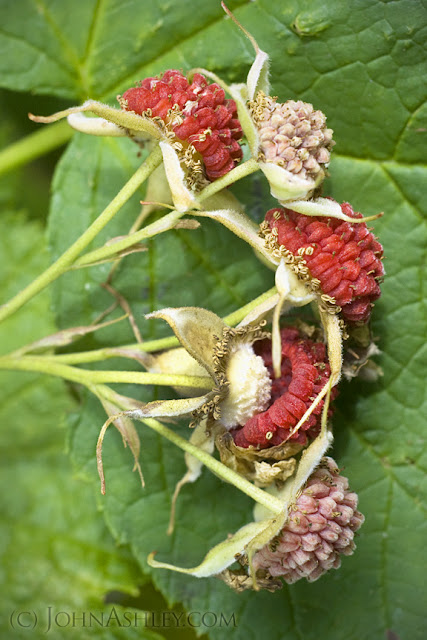 |
| Ripe thimbleberry fruit falling off the core |
By August, the low-elevation huckleberries have long since left the wooded fields amid much fanfare. Now it's the friendly thimbleberries that are ripe to finish out the summer berry season. I say "friendly" because they are one of the few blackberry cousins that are not armed with prickles.
White flowers give way to thimble-shaped fruits that are actually an aggregate of many "drupelets," which are almost dry at maturity. The ripe, red fruit literally falls off the plants and then falls apart in your hands. They've never been commercially successful because of this fragility.
But they're a great snack during a late-summer hike, and dedicated fans can cook up an easy thimbleberry jam. Just combine equal parts sugar and fruit in a heavy saucepan, bring to a boil and cook over medium heat for 5 minutes before canning.
Botanically speaking, thimbleberry is a deciduous, shade-tolerant shrub that is especially good at regenerating vegetatively. Birds are thought to be the primary disperser of the seeds, which remain viable in the soil for years. Seedlings become established in the first year after a disturbance (fire, windthrow, clearcuts, etc.), and then spread out by sprouting vigorously from rhizomes. First-year stems ("primocanes") sprout from below ground and only produce leaves. Lateral branches grow off the stems during the second year, producing the flowers and fruit.
The fruit is eaten by many native animals - bears and birds alike. But the leaves are only eaten occasionally by elk, deer, rabbits and beaver. Beaver and porcupine will also eat the stems and cambium. Shade from the big leaves provides hiding and thermal cover on hot summer days for many animals, including bears and deer.
On a couple of hot afternoons last week, I noticed ripe thimbleberries in most of the low elevation areas that I visited on the west side of Glacier Park. These humble hiking snacks were available on the trails emanating from Packers' Roost, and along the bike paths between West Glacier and Apgar. But I'm not a big fan, so I left the ripe thimbleberries for the birds and the "batologists" (that is, botanists who study the Rubus genus).

